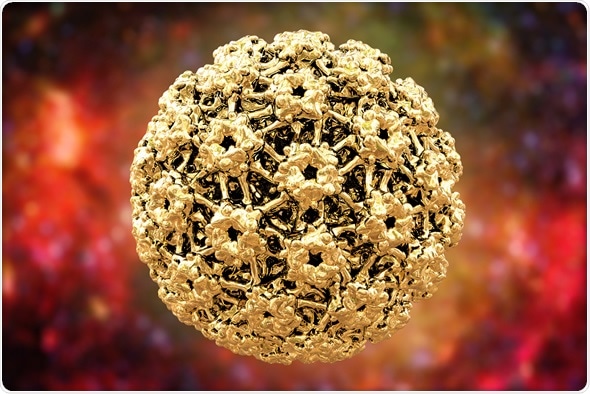The Human Papilloma Virus (HPV) is transmitted from human to human by skin contact or via moist membrane linings such as in the vagina, anus, mouth, or throat.
There are over 100 types of the viruses with some being linked to cancer while others have more mild effects.
Most humans are infected by at least one type in their lifetime. However, there are ways of preventing and reducing HPV infection.

Human papillomavirus (HPV) is a DNA virus from the papillomavirus family that is capable of infecting humans. Image Copyright: Tatiana Shepeleva / Shutterstock
Abstinence from Sexual Activity
One way to reduce the infections by the virus completely is by a person abstaining from all sexual intercourse. This includes oral, anal, and vaginal sex. This works because the virus is most infectious through sexual organs, the mouth, and throat.
You Are the Key to HPV Cancer Prevention
Circumcision
Research has shown that men who are circumcised tend to have a reduced risk of contracting the HPV infection.
Circumcision is the removal of the male foreskin on the penis. It may have to be removed for medical reasons such as a tight foreskin which does not move back easily or for religious reasons.
Jewish and Islamic males are often circumcised as children. This procedure reduces the risk of infection for their female partners as well.
Minimising the Number of Sexual Partners
Keeping the number of sexual partners of a person to the minimum limits their chances of encountering the HPV virus repeatedly.
Studies have shown that an eight-month interval between sexual partners helps allow the HPV infection to leave the body.
Using a Condom
Condoms can act as a barrier against some sexually transmitted diseases. When it comes to the transmission of HPV, the condom does not completely eliminate the risk of contracting the virus as HPV is spread through skin to skin contact. However, it can reduce the risk. Condoms should never be reused.
Being Careful with Warts
If a person does have a wart that results from a HPV infection, he or she should avoid picking the wart or biting their nails. Otherwise, the infection could be spread to another person through touch.
When a person has a genital wart, the best way to reduce the risk of spreading HPV is to avoid sexual activity or sticking to a monogamous relationship.
If the person has plantar warts (verucas or myrmecias) which are usually on the toes or foot, he or she should avoid spreading the HPV infection by covering their bare feet using shoes or sandals, especially in public recreation centres such as swimming baths and gyms.
Pap / Smear Tests
A person who is sexually active is advised to have regular smear or pap tests to monitor whether there are any initial signs of cancer such as pre-cancerous lesions.
In a smear test, a medical staff member will use a speculum to hold open the vagina so that they can use a small brush to obtain some cells from the cervix. The cells are analyzed to see if there are any abnormalities.
Specific Vaccines for HPV
A vaccine is substance which is injected into a person to protect them from a particular disease. The fluid used in the vaccine will have antigens from the disease but not enough to cause the disease. The body will produce antibodies to fight the disease and develop immunity should it come into contact with the virus again.
Vaccinations have been developed to protect people from types 16 and 18 of HPV that can cause 70% of cervical cancers. One vaccine protects against two types of HPV – 6 and 11, that cause 90% of warts.
HPV vaccinations are recommended for females between the ages of 9 and 26 as this is the age range it has the biggest impact on. Some people who are vaccinated may develop side effects such as headaches, dizziness, stomach pains, diarrhoea, soreness, and aching muscles.
References
Further Reading
Last Updated: Feb 26, 2019